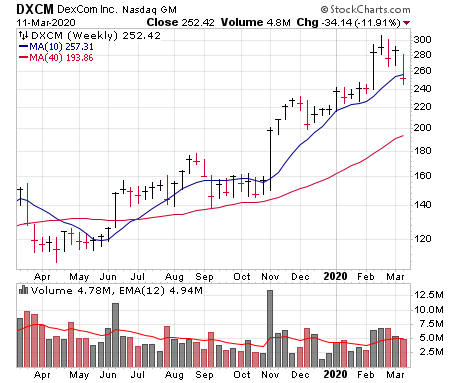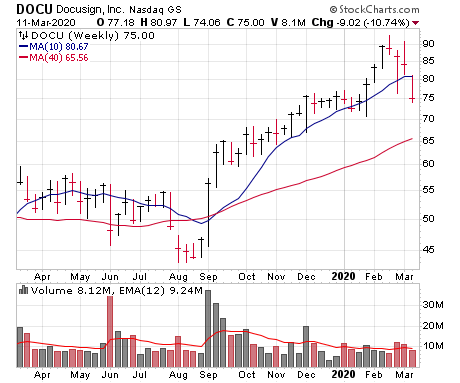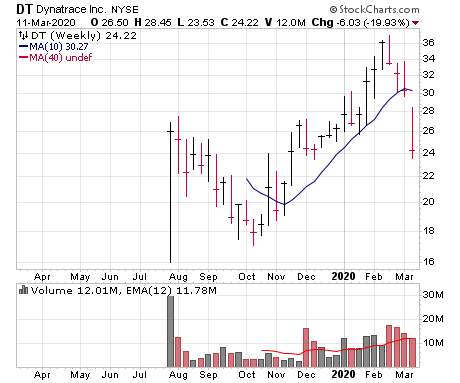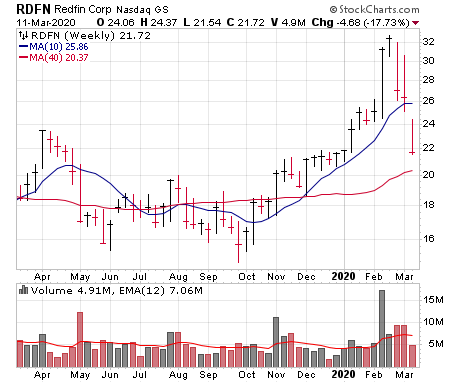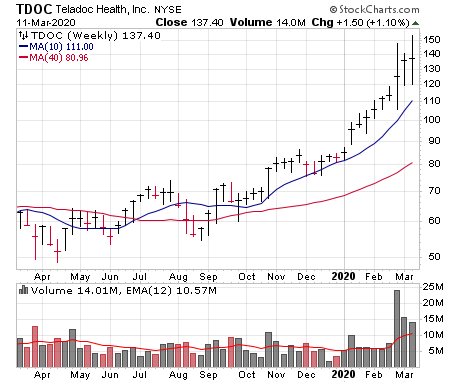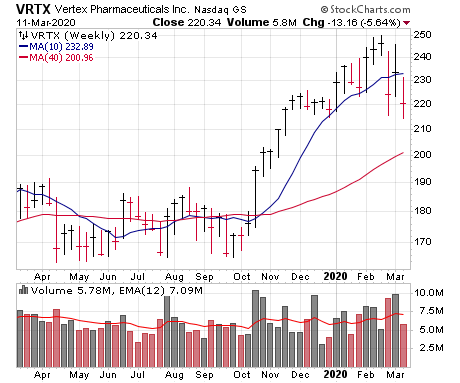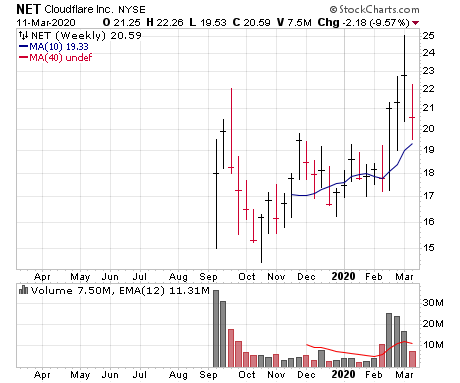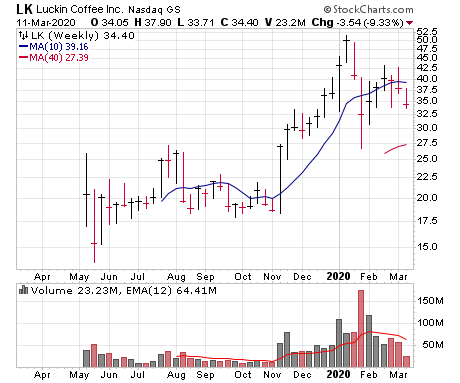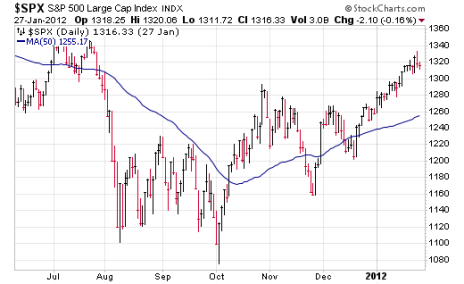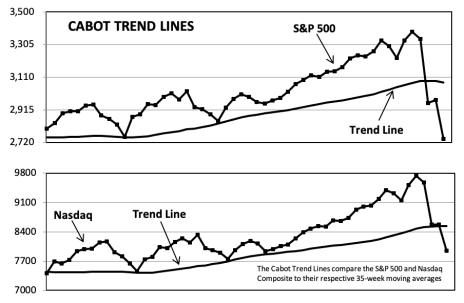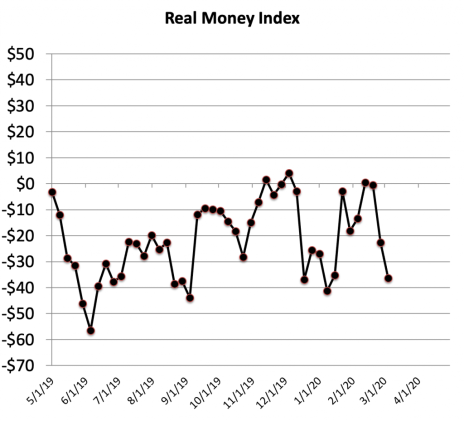The market has crashed during the past three weeks, with the major indexes down 25%-plus and many stocks down much more than that. We’re seeing some truly historic oversold extremes, which tell us a bounce could get underway at any time, but we’re also not seeing the market able to bounce from those extremes. The bottom line is the same as it’s been since late February: The sellers remain in control of the market and the vast majority of stocks, so we’re holding plenty of cash and paring back as need be.
Bigger picture, the market (and the country) will get through this pandemic in time, so it’s important not to lose your cool. There will be big money to be made down the road, and we’re on the hunt for stocks showing some minor relative strength and studying up on some new stories (a couple of which we highlight in the issue). But the goal is to get to the next uptrend in one piece--right now, you should respect the action and remain defensive.
Cabot Growth Investor 1441
[premium_html_toc post_id="200273"]
The Coronavirus Crash
We’re not big into labels when it comes to investing, as too many tie their decisions to them, but we think it’s fair to say the action since late February has been a rolling crash, as the indexes have plunged 26% to 32% from their recent highs in just three weeks as investor expectations regarding the virus have rapidly worsened.
While we’ve certainly taken our share of hits, we’re pleased to have quickly built up cash and had a few stocks that have hung in there. Even after today’s bloodbath, we’re hovering near breakeven for the year—not something to celebrate, but it beats the 20%-plus year-to-date loss for most major indexes.
But we’re focused on the future, not the past, and the big question on everyone’s mind is what comes next and what you should do about it. First off, these are the times you need to focus on what you can control—instead of guessing when a bottom will be reached, follow the system, which tells us to hold plenty of cash, limit new buying, sell losers and laggards, while giving any resilient stocks a bit of rope. It’s simple, but it works.
Now, to be fair, there are some legitimate signs that a bottom could be near; this week has brought some historic, 2008-type of oversold extremes that almost always occur near meaningful lows. But … so far, the market has ignored those extremes, which isn’t a great sign. The bottom line is that, if you are sitting with a bunch of cash, you don’t have to sell wholesale, but you also don’t want to simply “hold and hope” that a bottom is coming, or be buying a ton in anticipation of a rally.
What if you got caught sleeping and still own a bunch of duds? Again, selling wholesale probably isn’t the best idea, but it’s important to respect what’s going on—you want to make sure a bad situation doesn’t get much worse, so (generally speaking) consider at least paring back to stay in gear with the trend. Capital preservation is key.
But we don’t want this to be all negative, so we’ll end with the following: We’ve been at this game for 50 years and have seen many “firsts” that the market and country had to deal with, including double-digit inflation, Watergate, 20% interest rates, the 1987 crash, a S&L Crisis, Gulf Wars, a bunch of currency crises, the popping of the internet bubble, 9/11, a financial crisis and much more. After each time, the market (and the country) eventually worked its way out of it—and that will surely happen this time, too.
And when that time comes, there will be big money to be made by owning fresh leaders with revolutionary new products that are just getting going. But the key is to get from here to there with your portfolio, confidence and optimism intact—those that do will reap the rewards of the next bull phase.
What To Do Now
Right now, though, respecting the crash and remaining defensive is the right thing to do. In the Model Portfolio, we sold Dynatrace (DT), one-third of Dexcom (DXCM) and 20% of our remaining position in Teladoc (TDOC) earlier this week, and tonight we’re forced to sell half of our remaining position in ProShares Ultra S&P Fund (SSO). That will leave us with a cash position of around 67%.
Model Portfolio Update
Down markets are never fun, and the past three weeks have been particularly stressful with an endless series of gigantic moves and brutal headlines. We certainly haven’t been immune to many painful hits (yesterday saw most growth stocks get taken apart), but we’ve been paring back quickly during the past three weeks, helping the Model Portfolio to keep its head above water.
With tonight’s partial sale of SSO, our cash position will be up to around 67%, which is obviously a fair-sized cushion. From here, it’s going to mostly be about the action of the stocks we have left—we’re not craving more cash, per se, but if something unravels, we’ll obviously take action.
Meanwhile, we’re on the lookout for stocks that are resisting this bludgeoning; some leaders of the next sustained uptrend are probably beginning to reveal themselves during this mess. For now, though, it’s important to stay defensive and patiently wait for the buyers to step up to the plate.
Current Recommendations
| Stock | No. of Shares | Portfolio Weightings | Price Bought | Date Bought | Price on 3/12/20 | Profit | Rating |
| Dexcom (DXCM) | 386 | 7% | 216 | 11/15/19 | 248 | 15% | Hold 2/3 |
| DocuSign (DOCU) | 1,310 | 7% | 65 | 9/13/19 | 69 | 5% | Hold |
| Dynatrace (DT) | — | — | — | — | — | — | Sold |
| ProShares Ultra S&P 500 Fund (SSO) | 831 | 7% | 113 | 1/10/19 | 86 | -24% | Sell 1/2 |
| Teladoc (TDOC) | 841 | 9% | 78 | 11/01/19 | 119 | 52% | Hold |
| Vertex Pharmaceuticals (VRTX) | 414 | 7% | 199 | 11/8/19 | 204 | 2% | Hold |
| CASH | $839,935 | 63% |
Dexcom (DXCM 248)—Dexcom had been doing yeoman’s work trying to resist the market’s decline, but this week it’s finally succumbed to the selling pressure. Don’t get us wrong—shares aren’t a disaster compared to most (great relative strength today!), and the fact that the stock gave ground grudgingly (it’s only back to where it was in mid February; the market is back to where it was in January 2019!) backs up the view that the stock is owned by plenty of big fish that are hesitant to let it go, partly because its business combines growth and defensiveness (diabetics will continue to switch to CGMs over time). That said, we had a big position and a good profit, which, combined with the market’s implosion, prompted us to take partial profits via a special bulletin last night (Wednesday, March 11), selling one-third of our shares and holding the rest. Our leash isn’t limitless for the rest, but we’re aiming to give the remaining shares plenty of rope to correct and consolidate, as we still believe DXCM will see higher prices during the next sustained market uptrend. SOLD ONE-THIRD, HOLD THE REST.
DocuSign (DOCU 69)—DOCU has been whacked this week, diving below its 50-day line and falling back to its range in November; much better than the market as a whole, but still painful. (By the way, more than 94% of all stocks in the market are below their respective 50-day lines, to give you a sense of how bad things are.) We already booked partial profits back in late January, and our decision on whether to continue holding or not may come down to earnings, which are due out tonight; analysts are looking for sales of $266 million (up 33%) and earnings of five cents per share, but equally important will be the forecast, including whether management is seeing any increased (or decreased) adoption due to the virus—in theory, the wave of re-financings taking place should boost usage (many brokers e-sign some of the documents), and any prolonged shut-in of the economy could boost interest in digital signings and contract management. Obviously, the overall market will be hugely important, too, so we’ll just play it by the book—we believe DOCU has the makings of a longer-term winner, but if the stock falls much further on earnings, we’ll likely sell some or all of our remaining shares. HOLD.
Dynatrace (DT 22)—As we frequently write, good stocks can go bad in a hurry in a bad market, and that’s what Dynatrace did earlier this week, falling through our mental stop during Monday’s bloodbath. The weakness here is almost surely due to the market as a whole, so if the stock can shape up down the road, we could always revisit it—we think the application performance management business is still in the early phases of a big growth wave. But there’s no telling how things will play out, so we cut bait in a special bulletin Monday and are holding the cash. SOLD.
ProShares Ultra S&P 500 Fund (SSO 86)—We’ve patted ourselves on the back a bit regarding moves (and stock picks) that have kept the portfolio’s in one piece while the market has crashed. But to be fair, our handling of SSO has been poor—we did sell one-third of our position in late January, but never did sell any more on the way down, as the odds favored this being a “normal” correction within an ongoing bull market. Clearly, that hasn’t been the case. So the question is what to do from here. We still want to play the odds, and even though this market has been breaking rules, the historic selling we’ve seen does favor a meaningful low to be in place soon. However, we also can’t ignore the loss we now have on this position, not to mention the weakness. Long story short, we’re going to sell half our remaining position tonight, but also hold the other half and see how things play out from here. SELL HALF, HOLD THE REST.
Redfin (RDFN 17)—We let go of Redfin the day after our last issue went out (February 28), cutting the loss on our half position, and not surprisingly the stock has taken a big hit since then with the market. The long-term potential of Redfin’s lower-cost brokerage model remains big, but the stock will likely need plenty of time to repair the recent damage. SOLD.
Sea Ltd. (SE 42)—As we explained in last week’s regular update, in an effort to be completely honest and transparent, we decided to pull the plug on SE due to our editing error in the last issue. Fundamentally, things here are in great shape: The company released a very solid Q4 report that beat estimates on the top line (up 134% in local currency), driven by its booming e-commerce division (up 182%, including marketplace revenue up 224%!), and management’s expectation of higher take rates going forward. That said, the stock hasn’t been able to withstand this week’s pressure; it’s still holding better than most names (it’s near its levels from two weeks ago!), but it’s also toying with the mental stop we thought was prudent (in the 43 to 44 area). If you still own it, you can always give it a little rope, but we’d likely be out of it at this point. SOLD.
Teladoc (TDOC 119)—Teladoc has been one of the top stocks in the market, bolstered by a solid Investor Day last week that revealed plenty of good things (including the fact that management has 90% visibility in 2020’s revenue at this point) and the fact that the current pandemic is likely to increase demand for (and utilization of) its telemedicine services. Bigger picture, we’re hopeful TDOC, which just got going from a huge consolidation at the start of the year, is in the early stages of its run; telemedicine may just be hitting the tipping point of acceptance, with the virus catastrophe accelerating that. However, there’s no question shares have had a huge run and are now coming under pressure. We sold one-third of our initial holdings a couple of weeks back, and on yesterday’s special bulletin, we sold another 20% of what we had left. (Doing the math, we now have just over half our original shares.) As usual, the plan is to give our remaining shares room to correct and consolidate from here. SOLD 20% MORE, HOLD THE REST.
Vertex Pharmaceuticals (VRTX 204)—Vertex has hit the skids along with most everything in the market, but it does have some support not too far below here from the 200-day line. Just as important, management threw out some good news this week. Vertex announced this week that it’s confident in its supply chain, that it hasn’t seen any effects from the virus on the launch of Trikafta or other elements of its business, and that its 2020 business outlook remains unchanged. Of course, if the stock can’t find support going forward we’ll take action, but having already booked partial profits and with such solid, reliable business prospects, we advise holding your remaining shares. HOLD.
Watch List
- Bilibili (BILI 24): BILI looks a lot like a Chinese YouTube, albeit with a heavy emphasis on produced content and some other features (e-sports), usually for younger viewers. The stock is trading where it was in early February, which is impressive.
- Cloudflare (NET 19): Cloudflare has a new, global network built specifically for the cloud age. See more below.
- Inphi (IPHI 94): IPHI has been hit this week but is still north of its 200-day and found some big-volume buying the prior couple of weeks.
- Luckin Coffee (LK 32): LK isn’t as resilient as some of its Chinese peers, but it’s far from a disaster and it has one of the better growth stories. See more below.
- Tesla (TSLA 557): It needs work and time, but we continue to think TSLA’s current correction will lead to another big advance down the road.
- Zoom Video (ZM 109): Zoom’s always had a great growth story, and the virus should boost business in both the short and long term. See more below.
Other Stocks of Interest
Cloudflare (NET 19)—The move to the cloud has obviously helped some direct players (like cloud software firms), but we’re now seeing some other opportunities emerge. One of them involves the network itself—old on-premise hardware patches like firewalls, load balancers, optimizers and other performance enhancements are becoming obsolete. The solution for a growing number of firms is Cloudflare’s global cloud network that can be found in 200 cities and 90 countries (interconnecting with more than 8,000 networks) and delivers all of the key network functions as a service—with all the benefits of being in the cloud (quick setup, always online, scalable). The minutiae of the story and products are something only an engineer can love, but suffice it to say that Cloudflare appears to have the better/faster/cheaper/more flexible network solution for businesses of all sizes, and the results reflect that—18% of the top 10,000 trafficked websites use Cloudflare, as do 13% of the Fortune 1000, and revenues have been increasing in the 50% range for many quarters as current clients expand their usage and new customers sign up. The company just came public last September and built a good-looking IPO base for a few months, but what caught our eye is the stock’s big-volume advances during the past three weeks. Sure, it’s taken its lumps this week, but this seems like the type of new name that could be a fresh leader during the next uptrend. It’s worth watching.
Zoom Video (ZM 109)—We wrote about Zoom (the leading new-age videoconferencing platform) before the virus plunge came about, as it was one of many of last year’s IPOs that went bust for a while but was beginning to shape up. Today, while other IPOs have gone up in smoke, ZM has become one of the top glamour stocks in the market, partly thanks to the virus, as more businesses and classes doing work/school from home could dramatically expand its market. (One fund manager I talk to told me his daughter’s college is cancelling all in-room classes this semester and using Zoom to teach!) To be fair, once this virus panic passes (it will eventually), stocks like ZM could fall back as buyers look elsewhere—but there’s a real growth story (and numbers) here that, virus or not, has a good chance of driving the stock higher. The big idea is that Zoom’s offering is built from the ground up for video, whereas competitors were basically using voice conferencing solutions that were plussed up. The company is also expanding into the unified communications market, allowing businesses of all sizes to have phone/messaging/video offerings that fit in with the modern, mobile workplace. Business has been humming for a while (sales up 78% in Q4), and the firm has turned profitable (earnings expected to rise 44% this year, which is almost surely low), is attracting a bunch of new customers (81,900 with at least 10 employees, up 62% from a year ago, with faster growth among larger customers) and has inspiring sub-metrics (same-customer growth rate north of 30%). The stock has been super-strong, but also super-volatile; we think the future here is very bright, with the worldwide virus-induced shutdown likely boosting business even more.
Luckin Coffee (LK 32)—There aren’t too many revealing things during a market meltdown, but one surprising thing we’ve seen is a general resilience among Chinese stocks—it’s possible the market thinks that China, which was the first into the virus fire, might be the first out of it. Luckin Coffee isn’t necessarily the best-looking stock in the group (BILI, JD, VIPS are all a bit stronger), but it definitely has the biggest story: The company has taken China by storm, opening thousands of quick-service coffee locations around the country; it now has more stores than Starbucks! But these aren’t big places where people can lounge and chit-chat—instead, customers will often order and pay for their coffee (and other stuff) online, set a pick-up time, and then walk to it and grab it. That’s it! It’s bare bones, but that leads to lower costs (for Luckin and consumers), and the company is expanding into more offerings, including tea, nuts and juices; in Q3, 45% of products sold were not coffee. Growth has been mind-boggling (revenues were up 517% in the last quarter; store count up 209%; items sold up 670%!), and while earnings are in the red, store-level margins are improving rapidly. Of course, the virus-induced shutdown of the country’s economy likely has (and will) hurt business in the short-term, but the stock has shown some relative strength of late—after a big run into mid-January, LK was nailed during the first virus selloff, but this time around it’s found support a few points higher. The chart, like most, still needs some work, and LK has yet to report Q4 earnings, but the longer it can hang in there, the better the chance its prior uptrend can resume.
Three Things to Remember Right Now
There’s no question the action of the past three weeks has been a once-every-decade-or-two type of event—and with that kind of action (and historic volatility) comes a furious flow of opinions, commentary and big-font headlines that has investors licking their wounds and as confused as ever.
Don’t get us wrong, we’re not immune to feeling queasy when things are tanking. But we do stick with the actual evidence, which, along with a knowledge of how the market actually works, keeps the odds in our favor. So we thought it would be a good time to share the three things to focus on instead of the varying headlines.
#1: This week has brought many historic extremes usually associated with intermediate-term lows. Many pundits talk about “oversold” every time the market falls for a few days, but that is often deceiving—oversold can easily (and often does) become more oversold. But when you get truly extreme readings, they’re worth nothing.
Today, for instance, we saw the VIX Volatility Index reach a high of 69; saw nearly 4,300 stocks hit new lows on the NYSE and Nasdaq combined; and saw the Bullish Percent on the NYSE (basically tells you have many stocks are holding above prior intermediate-term lows) of just 7%. All three readings are the worst since 2008!
These and other measures say that a lot of selling has been done and a lot of bad news has been discounted. Was it enough? Time will tell; we also saw huge readings on Monday, for instance, and that didn’t bring in any buyers. Still, if the market can bounce well sometime in the days ahead, it would raise the odds of a meaningful low being put in place.
#2: Bottoms are usually a process, not an event. That said, even if we’ve hit what turns out to be a notable low point, the odds favor plenty of ups, downs and potentially retests of that low in the weeks ahead. Our studies show that successful retests tend to occur four to eight weeks after the initial “primary” low, though of course every situation is different.
The situation in 2011—when Europe had debt issues—was a classic example. After stalling out for a while, the S&P collapsed nearly 20% in a matter of days during early August, bringing many historical oversold readings (more than 2,000 total issues hitting new lows, etc.). But instead of a persistent rally, we saw a quick retest two weeks later, a choppy upmove into the falling 50-day line, and then another retest of the lows in early October. Even in November and December there were sharp dips to shake the tree before a sustained advance emerged.
“But Mike,” you say, “I remember the 2018 implosion, when we rallied in a straight-up fashion.” This is true—we’re dealing with odds, not certainties. But in the vast majority of cases, some bottom-building is in order, and the couple of times it wasn’t, the market had usually been losing ground for three months or more beforehand (a lot of people had already bailed). We’re open to anything, but it’s more likely than not that some sort of bottoming process will be eventually be needed.
#3: Expect a mix of new and old leadership during the next uptrend. Speaking of 2018, one of the major happenings was that the market leaders not only fell, but imploded—Nvidia (NVDA) was one of the top liquid leaders back then, and it fell 55% in eight weeks! Thankfully, so far, we don’t see that type of action among most leaders.
Thus, it’s more likely the next rally (whenever it begins) will probably bring a mix of recent leaders (ideally including a couple of the stocks we own) and some newer names that emerge, be they IPOs (like Cloudflare, written about earlier in this issue) or something like Regeneron (REGN, shown here). That stock is perking up after years in the doghouse as a competitor to its Eyela macular degeneration treatment has major problems, which is likely to drive huge market share to Regeneron. The stock displayed a massive volume clue two weeks ago and is holding up well. Meanwhile, other investor favorites of the past couple of years that have been hit may fade to the background.
Of course, there will be time to sort out the leaders once the market gets healthy. In the meantime, it’s important to keep the above three facts in mind—having a rough game plan is always a plus, especially in such hectic and volatile times.
Cabot Market Timing Indicators
The market’s plunge this week has brought many extremes (4,000-plus new lows today!) that, ideally, will help the market form a workable in the not too distant future. But that doesn’t change our thinking—with the trend clearly down, we’re in a defensive stance, focusing on capital preservation while looking for leaders of the next advance.
Cabot Trend Lines: On The Fence
Our Cabot Trend Lines have remained positive for most of this decline (the S&P 500 has been below its 35-week line, but the Nasdaq closed less than 1% above its own the two prior weeks), but it’s now on the fence—both indexes are likely to close below their respective trend lines tomorrow. Even so, a sell signal comes when both indexes close two straight weeks below their respective 35-week line; thus, the longer-term trend is effectively neutral here, and the next few trading days will be key.
Cabot Tides: Bearish
Our Cabot Tides, on the other hand, turned negative on February 24, which was a great signal. You can see the S&P 400 Midcap (shown here) is now miles below its moving averages; for a new buy signal, remember, we need to see most indexes we track get above their lower (25-day) moving average and for that moving average to turn up—something that’s almost surely going to take some time. With the intermediate-term trend down, caution remains in order.
Cabot Real Money Index: Positive
On a positive note, our Real Money Index has picked up on the panic among investors—each of the first two weeks of this crash saw more than $20 billion flow out of equity funds and ETFs (we get this week’s reading tonight), which has driven the Index well into positive territory. As with all sentiment measures, this one doesn’t pinpoint lows, but such withdrawals have historically been a good sign when looking out a few weeks.
Charts courtesy of StockCharts.com
The next Cabot Growth Investor issue will be published on March 26, 2020.
Cabot Wealth Network
Publishing independent investment advice since 1970.
CEO & Chief Investment Strategist: Timothy Lutts
President & Publisher: Ed Coburn
176 North Street, PO Box 2049, Salem, MA 01970 USA
800-326-8826 | support@cabotwealth.com | CabotWealth.com
Copyright © 2020. All rights reserved. Copying or electronic transmission of this information is a violation of copyright law. For the protection of our subscribers, copyright violations will result in immediate termination of all subscriptions without refund. No Conflicts: Cabot Wealth Network exists to serve you, our readers. We derive 100% of our revenue, or close to it, from selling subscriptions to its publications. Neither Cabot Wealth Network nor our employees are compensated in any way by the companies whose stocks we recommend or providers of associated financial services. Disclaimer: Sources of information are believed to be reliable but they are not guaranteed to be complete or error-free. Recommendations, opinions or suggestions are given with the understanding that subscribers acting on information assume all risks involved. Buy/Sell Recommendations: All recommendations are made in regular issues or email alerts or updates and posted on the private subscriber web page. Performance: The performance of this portfolio is determined using the midpoint of the high and low on the day following the recommendation. Cabot’s policy is to sell any stock that shows a loss of 20% in a bull market or 15% in a bear market from the original purchase price, calculated using the current closing price. Subscribers should apply loss limits based on their own personal purchase prices.

